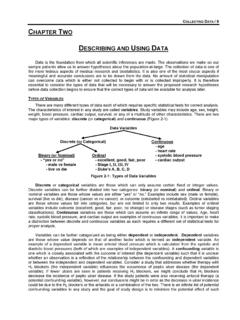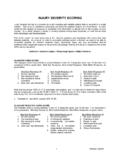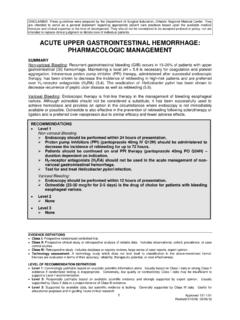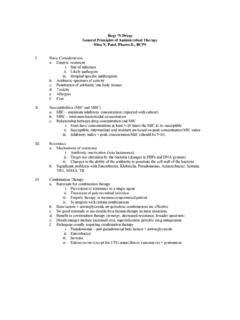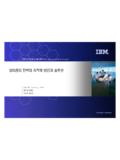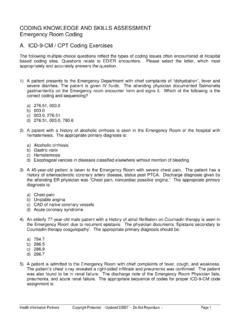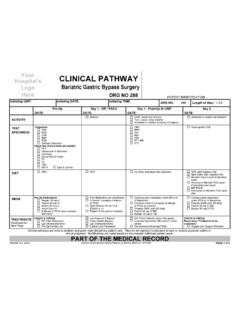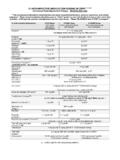Transcription of Chest tube management - SurgicalCriticalCare.net
1 DISCLAIMER: These guidelines were prepared by the Department of Surgical Education, Orlando Regional Medical Center. They are intended to serve as a general statement regarding appropriate patient care practices based upon the available medical literature and clinical expertise at the time of development. They should not be considered to be accepted protocol or policy, nor are intended to replace clinical judgment or dictate care of individual patients. EVIDENCE DEFINITIONS Class I: Prospective randomized controlled trial.
2 Class II: Prospective clinical study or retrospective analysis of reliable data. Includes observational, cohort, prevalence, or case control studies. Class III: Retrospective study. Includes database or registry reviews, large series of case reports, expert opinion. Technology assessment: A technology study which does not lend itself to classification in the above-mentioned format. Devices are evaluated in terms of their accuracy, reliability, therapeutic potential, or cost effectiveness. LEVEL OF RECOMMENDATION DEFINITIONS Level 1: Convincingly justifiable based on available scientific information alone.
3 Usually based on Class I data or strong Class II evidence if randomized testing is inappropriate. Conversely, low quality or contradictory Class I data may be insufficient to support a Level I recommendation. Level 2: Reasonably justifiable based on available scientific evidence and strongly supported by expert opinion. Usually supported by Class II data or a preponderance of Class III evidence. Level 3: Supported by available data, but scientific evidence is lacking.
4 Generally supported by Class III data. Useful for educational purposes and in guiding future clinical research. 1 Approved 05/16/2005 Revised 10/24/2009. 9/28/2016 Chest TUBE management SUMMARY Tube thoracostomy, or Chest tube (CT) placement, is often indicated for the treatment of pneumothorax, hemothorax, or pleural effusion following traumatic injury or thoracic surgery. Subsequent management of the CT must be individualized to the patient, taking into consideration the reason for CT placement, whether or not the patient has had pulmonary resection, and whether the patient is mechanically ventilated.
5 Premature CT removal, as well as unnecessary delays in CT removal, leads to increased hospital stays and costs. INTRODUCTION Tube thoracostomy, or Chest tube (CT) placement, is often indicated for the treatment of pneumothorax (PTX) and/or hemothorax (HTX). Although there is generally agreement among surgeons on the indications and technique for CT insertion, there is little consensus on the subsequent management of these tubes once placed. management practices are often based on institution and physician-specific training and preferences developed from anecdotal experience.
6 The ideal CT management algorithm has yet to be determined. Specifically, wide variation in management practices exists with regards to the timing and parameters under which CTs should be removed, the best method of removal, and the need for Chest X-rays pre- and post-CT removal. RECOMMENDATIONS Level 1 CT drainage should be 2 ml/kg/day before removal. Level 2 CTs can be removed equally safely at end-inspiration or end-expiration. CTs may be safely removed on suction. A brief trial of waterseal prior to CT removal may allow occult air leaks to become clinically apparent and reduce the need for CT reinsertion due to recurrent pneumothorax.
7 Such trials, however, will generally increase hospital length of stay and the number of Chest radiographs (CXRs) obtained. After pulmonary resection, small air leaks will resolve significantly more quickly if the CT is placed to waterseal In the setting of penetrating trauma to the Chest , a single dose of Ancef 2 gm IV should be administered prior to CT insertion. Level 3 In mechanically ventilated patients, a CXR obtained between one and three hours after removal of a CT is sufficient to identify a recurrent pneumothorax.
8 A daily CXR is not indicated to monitor CTs in the intensive care unit. Routine monitoring and patient care will identify the need for CXR based on clinical necessity. 2 Approved 5/16/2005 Revised 10/24/2009, 9/28/2016 LITERATURE REVIEW What volume of CT drainage is appropriate to consider removal of the tube? In 2002, Younes performed a prospective randomized study to evaluate the timing of CT removal in regards to the daily CT drainage volume (1). Specifically, the study compared removal when drainage was 100 ml/day, 150 ml/day or 200 ml/day.
9 Fluid reaccumulation and the need for thoracentesis were evaluated. No major differences were noted between the groups, concluding that increasing the threshold of daily drainage to 200 ml before removing the CT could lead to quicker removal of the CT, reducing hospitalization time and overall cost. Davis defined drainage resolution as <2 ml/kg (2). Although the study did not specifically evaluate patients for the recurrence of pleural fluid, this parameter was not reported to adversely influence study outcomes.
10 Should CTs be removed at end-inspiration or end-expiration? Bell designed a prospective, randomized study to evaluate whether a recurrent pneumothorax (PTX) was more likely with CT removal at end-inspiration or end-expiration (3). Of 102 CTs in 69 blunt and penetrating trauma patients, 50 were assigned to end-expiration removal vs. 52 to end-inspiration removal. The results showed an 8% rate of recurrent PTX in the end-inspiration group and 6% rate in the end-expiration group (p= ). No other factors were identified that predisposed to recurrent PTX.


